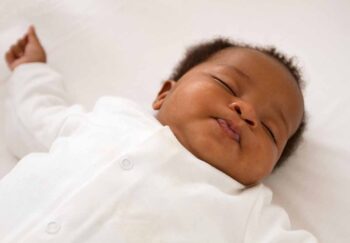The pursuit of the perfect sleep aid for newborns makes a lot of sense. Every new parent is trying to figure out how to get enough sleep to function. Unfortunately, many products designed to help babies sleep better end up being unsafe. The latest tragic addition to a market to help sleep-deprived parents? Weighted sleep sacks and blankets.
Rachel Moon, MD, is a UVA Health Children’s pediatrician and a safe sleep expert. Moon helped write the American Academy of Pediatrics’ updated recommendations for reducing sudden infant death syndrome (SIDS). With more than a decade of studying both the causes and prevention of SIDS, few people are more informed on the importance of safe sleep.
She empathizes with new parents. But she agrees with the proposed federal legislation to ban weighted sleep sacks. She shares:
- 3 reasons to never put your baby under a weighted blanket or in a weighted sleep sack
- Safer ways to help your baby sleep
- Why it’s healthy for your baby to wake through the night
1. Babies Are Built Different
Can you squeeze through a space only 10 cm wide? Me either. Adults’ ribs are made out of hard bone. But babies who are less than a year old have cartilage instead of bone. “It takes quite a while to harden,” Moon explains. Cartilage is a type of connective tissue found in the tips of your ears and nose. It’s firm, but flexible.
That means resting a weight on their chest is dangerous. “If you put a weight on it, it’s going to deform, and it’s going to press down on the lungs and on the heart,” Moon said. “And that’s going to make it harder to breathe.”
2. Safety Standards Don’t Exist
There are no official safety standards on the amount of weight used in weighted sleep sacks or blankets for babies. A lack of safety standards means a lack of consistency. So weights range from a half pound to nearly 2 pounds. The Nested Bean has a central weight. This design was inspired by the creator soothing their child with a hand on their chest. The Dreamland baby sack’s weight is distributed throughout, more like a weighted blanket. Both companies claim to follow the best safety standards.
But there are no official standards. And both companies have had reported incidents of babies being negatively impacted by their products.
“With no safety standards you could have any amount of weight in these products,” Moon says. “Some of these products have a pound of weight in them. And that’s more than 10% of a newborn’s body weight.”
In addition to the risk of compression, extra weight on a baby means they can’t move the way they might need to. And if they roll over onto their belly, they might not be able to pull their head free to breathe.
3. Lower Oxygen Levels with Weighted Sleep Sacks
Weighted sleepwear for babies has become popular as an outgrowth of weighted blankets. Weighted blankets are touted to help people feel less anxiety and sleep through the night. Many believe they especially benefit those with ADHD and autism. But this data is largely anecdotal.
Fewer studies have been done on babies in weighted sleep sacks. In one of the studies, researchers saw a concerning trend: As the babies slept under the weighted sleep sacks, their oxygen levels went down, though never to a dangerous level. And their heart rates went up.
“These are signs that are concerning,” Moon says. “And, the researchers stopped the study at 2 minutes. It’s unclear why. Most babies sleep for more than 2 minutes. So, we want to know if these are safe for a more normal sleep time. But there isn’t any data to show that.”
Change Your Expectations
As an adult, we all want to sleep through the night. But this isn’t a realistic goal with a newborn.
“Young infants shouldn’t sleep through the night,” Moon says. Ideally, in fact, newborns should wake every 2 hours to eat. It won’t be until they’re 2 to 3 months old that some (not all) start sleeping for 5-6 hours.
When you realize that, it’s not surprising that every sleep gadget or device is going to fail with babies. But that’s a good thing.
“Frequent awakenings are protective for babies,” Moon says.
Lack of Sleep Getting You Down?
Exhaustion can contribute to depression and frustration.
Better Sleep Tips for Your Baby
Safe sleep guidelines are clear. And the improved safety has contributed to a sharp decline in SIDS deaths. But what sleep tips focus on quality of sleep in addition to safety? Moon has some proven ideas.
“Make sure the baby is drowsy but not fully asleep when you put them in the crib,” she explains. When they fall asleep in their crib, they aren’t surprised to wake up there. And can self-soothe and go back to sleep.
Imagine it this way. If you’re asleep in your bed and a noise makes you get up, you’ll likely go right back to sleep. Now imagine you wake up in a completely different location. It’s probably going to be harder to go back to sleep. You might even scream a little bit.
And while weighted sleep sacks are dangerous, regular sleep sacks can provide comfort. A well-wrapped swaddle can also help.
Other safe ways to improve newborn sleep:
- Pacifier
- Create a routine
- Use a white noise machine
- Adjust temperature range to 68-72 degrees
With an infant nearby, you most likely won’t get a solid 8 hours. But you’ll both sleep a little better, especially knowing that your baby is safe.


